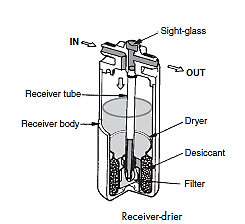SKEDSOFT
Introduction:
A receiver-drier is used when a thermostatic expansion valve metering device is used and is positioned between the condenser and the thermostatic expansion valve. The accumulator is fitted between the evaporator and the compressor.
The receiver-drier

The function of the receiver drier is as follows:
1. To ensure the system is free from dirt preventing any excessive wear or premature failure of components.
2. To remove moisture from the refrigerant ensuring no ice can form on any components within the system which may cause a blockage and to ensure no internal corrosion can form.
3. To act as a temporary reservoir to supply the system under varying load conditions.
4. To allow only liquid refrigerant to flow to the expansion valve.
5. To act as a point for diagnostics (sight glass sometimes fitted).
Operation
- Refrigerant entering the receiver-drier in an ideal system will be in a liquid state. If the system is under heavy load the condenser may have not been efficient enough to completely condense the refrigerant.
- This means a small amount of vapour may be present. Liquid and vapour can enter the receiver through the inlet where it will separate.
- Liquid will fall to the bottom of the receiver while vapour will rise to the top. The outlet is connected to a receiver tube internally which has a pickup point at the bottom of the receiver where the filter is positioned.
- The refrigerant flows through the desiccant and filter to get to the outlet pickup tube. This ensures that only liquid refrigerant flows to the expansion valve.
Sight glass
A sight glass is not used on R134a systems because the refrigerant has a cloudy appearance in its normal condition.
Fusible plug (pressure relief valve)
If adequate cooling of the condenser is not provided or the cooling load becomes excessive a fusible plug will release the excessive pressure to reduce the possibility of a burst pipe. The fusible plug contains metal which has a melting point of approximately 100–110°C.
Pressure relief valve
The problem with a fusible plug is that once the metal melts you lose the full contents of the refrigerant.
Accumulator
An accumulator is used when an FOV metering device is used. The accumulator is fitted between the evaporator and the compressor. The function of the accumulator is as follows:
1. To ensure that the refrigerant leaves the accumulator as a vapour and not a liquid state for the compressor to induce.
2. To ensure it is free from dirt to stop any excessive wear or premature failure of components.
3. To remove moisture ensuring no ice can form on any components within the system which may cause a blockage and to ensure no internal corrosion can form.
4. To act as a temporary reservoir to supply the system under varying load conditions.
5. To add lubricating oil for system components like the compressor.6. Often to house the low pressure switch/sensor.

Operation
- The refrigerant enters the accumulator from the evaporator in liquid/vapour form. It enters through the inlet (3) creating a vortex and flowing around the cap (4).
- The refrigerant passes through the desiccant where it is cleaned and moisture is removed. The vapour collects under the cap (4) where it is extracted through the outlet.
- During extraction it passes through a U tube in which it is mixed with oil from the small bleed hole (6).
- This bleed hole allows very small quantities of liquid refrigerant mixed with lubricating oil (3%) to flow with the refrigerant vapour to the compressor. Because the liquid refrigerant vapour is in such small quantities there is no danger of compressor damage.